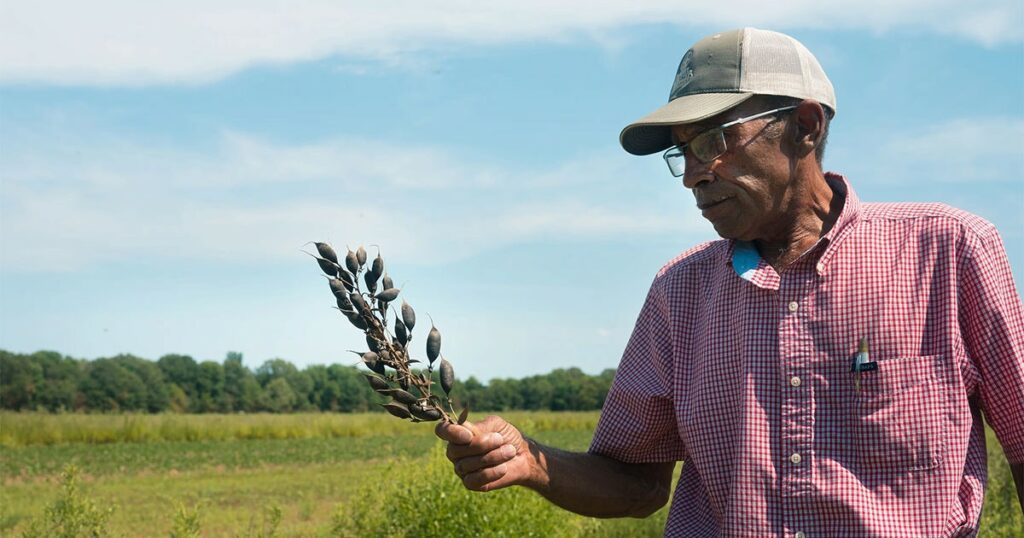On a bright spring day in the Arkansas Ozarks, Carolyn Tedford and Jonathan Young inspect Tedford’s crop. Bluebirds sing from a power line as Young commends her for a particularly vivacious patch of wild bergamot, which in a few months will burst with showy purple flowers. Pulling weeds as she goes, Tedford offers a matter-of-fact explanation for the plants’ vigorous growth: “They can feel my love.”
After retiring from a 30-year military career in 2016, Tedford decided to fix up the family farm where she spent her childhood growing vegetables and grazing cattle. Yet she and her brother Norris, both in their 60s, were hesitant to return to that kind of backbreaking work. They also wanted a crop that could support pollinators and other wildlife. So with Young’s help, they turned to a different product: seeds.
Young leads Audubon Delta’s Native Agriculture to InVigorate Ecosystems (NATIVE) program, which since 2011 has recruited farmers from across Arkansas to help meet growing demand for seeds to rebuild degraded wildlife habitat. Climate change, development, and other drivers of ecological destruction have eroded native plant communities that undergird thriving ecosystems. Conservationists are eager to repair the damage, but a lack of locally adapted seeds has stymied government and nonprofit efforts to restore native vegetation and the biodiversity it supports. A 2023 report by the National Academies of Sciences, Engineering, and Medicine described the shortage as an urgent challenge and pointed to regional partnerships as part of the solution.
That’s where programs such as NATIVE come in, Young says: “The whole idea behind the project is to make these local seed resources available to support larger-scale restoration in Arkansas using the seeds that have been on our landscape for millennia.” The initiative also emphasizes partnering with farmers from groups historically underserved by government agriculture programs; of the 10 or so producers enrolled each season, most run small family farms and are new farmers, veterans, or people of color.
Even for plant species that grow across North America, restoration projects are most successful when they use varieties genetically adapted to the local environment. In the Southeast, there aren’t enough of the right seeds to restore native prairies, barrens, and other grasslands, which have dwindled to less than 10 percent of their historic range, says Marcello De Vitis, a former seed collection coordinator with the Southeastern Grasslands Institute. “Even if you want to follow best practices, you might not find seed for the species that you want,” he says.
The NATIVE project’s efforts to meet that demand focus on around 20 “workhorse” species of perennial grasses and wildflowers that are relatively easy to cultivate on small farms, says botanist Jennifer Ogle, collections manager at the University of Arkansas Herbarium. She and Young train volunteers to collect seeds from ecosystems across the state. Roundstone Native Seed, a commercial operation in Kentucky, grows them into young plants that the NATIVE program distributes to participating farmers free of charge, thanks to funding from the USDA Natural Resources Conservation Service. Young helps participants plant the starter seedlings on their fields and provides technical support throughout the growing season. The farmers raise the perennial plants, harvest the seeds they produce year after year, and send them back to Roundstone, which handles processing and sales. The farmers and Roundstone share the proceeds.
The additional income from selling native seeds helps to keep those farms economically viable. “I had been doing commodity crops all my life—cotton, soybeans, wheat, rice—and it was just getting harder and harder to make a profit,” says NATIVE participant Stephan Walker, a fourth-generation farmer who also works as an agricultural consultant for the University of Arkansas at Pine Bluff. On retired teacher Ray Wofford’s family farm in Casscoe, where Mississippi Kites pluck dragonflies from the air above rows of soybeans, native perennials take up barely 12 percent of the cropland but produce around 30 percent of his annual profits.
As with any crop, growing native seeds requires a little luck and a lot of hard work. “I tell our farmers that we’re growing native wildflowers, not magic beans,” Young says. But their labor has a real impact, he says. The farms themselves—and the grassland habitat they help rebuild—now sustain some of the state’s most vulnerable birds, such as Smith’s Longspur and Northern Bobwhite. Thousands of pounds of NATIVE project seeds have supplied restoration projects along levees, among solar arrays, and in Audubon-designated Important Bird Areas across Arkansas, Young says. Now he is laying the groundwork to expand the project to include Louisiana and Mississippi, the other states where Audubon Delta operates.
Farming can be grueling at any age, let alone as a retiree, but Norris Tedford says growing seeds is less physically taxing than raising food crops. And the farmers get more out of it than just a boost to their bottom line. The Tedfords are gratified to see butterflies abound on their family’s land and to know that seeds from Carolyn’s prized bergamot are helping sustain wildlife throughout the region. “If I were younger,” she says, “I’d do more.”
A version of this piece originally ran in the Fall 2024 issue as “Harvesting Habitat.” To receive our print magazine, become a member by making a donation today.
Source link : http://www.bing.com/news/apiclick.aspx?ref=FexRss&aid=&tid=66ec5c4c21a44f2082bdde2db704d420&url=https%3A%2F%2Fwww.audubon.org%2Fmagazine%2Fthese-arkansas-farmers-bird-habitat-cash-crop&c=15210567063038208992&mkt=en-us
Author :
Publish date : 2024-09-19 04:44:00
Copyright for syndicated content belongs to the linked Source.
